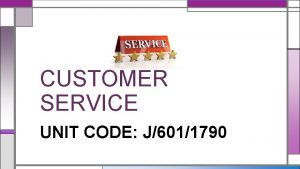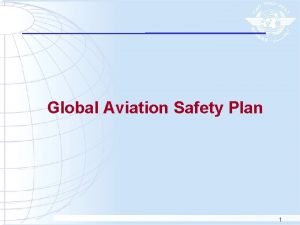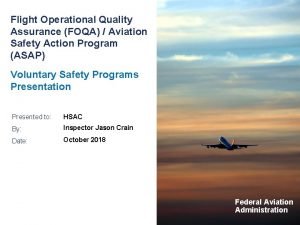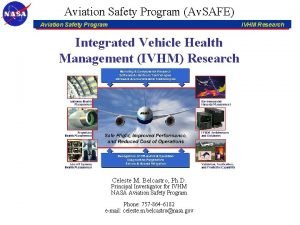Safety Culture in the Aviation Industry the example














- Slides: 14

Safety Culture in the Aviation Industry: - the example of Fatigue Risk Management Highways England, 14 th March 2017 Dr Paul Jackson www. clockworkresearch. com

The Aviation Industry • Safety-critical work, demanding work environment • Commercial pressures • Round-the-clock operations – circadian disruption • Heavy reliance upon shiftwork • Working when should be asleep, trying to sleep during day • Reluctance to report • Incentives to operate fatigued • Consequently, workforce fatigue is a significant hazard www. clockworkresearch. com

Consequences of fatigue Microsleeps while operating More than 10 occasions in last 12 months: • Cabin Crew 42% • Flight Crew 25% Microsleeps while driving home More than 10 occasions in last 12 months: • Cabin Crew 30% • Flight Crew 24% www. clockworkresearch. com

Traditional control: Hours of Work regulations • Simplistic illusion of safety management: - within the limits you are safe - outside the limits you are unsafe. Regulatory authorities now require a more scientific approach to the management of fatigue, based on analysis of data specific to the operation www. clockworkresearch. com

Fatigue Risk Management FRM POLICY EFFECTIVE REPORTING SYSTEM Fatigue Risk Management (FRM) Processes Data Collection and Hazard Identification Risk Assessment Risk Management FRM Safety Assurance Processes Performance Monitoring SPIs (Safety Performance Indicators) Managing changes that may impact on the FRMS Audit and review COMMUNICATION: SAFETY PROMOTION AND FEEDBACK FATIGUE MANAGEMENT TRAINING PROGRAMME www. clockworkresearch. com

Preparing the organisation • Just culture: open, fair, equal • Top level endorsement/commitment • Union support and involvement • Consultation with workforce • Management Education Programme • Steering Group • Communication plan: raising awareness “An atmosphere of trust in which people are encouraged, even rewarded, for providing essential safety-related information, but in which they are also clear about where the line must be drawn between acceptable and unacceptable behaviour. ” www. clockworkresearch. com

5 COMMON MISTAKES MADE WHEN IMPLEMENTING FRM

1 Management don't demonstrate their commitment to FRM For FRM to be implemented successfully it is essential that management take their responsibilities seriously, and demonstrate their commitment through actions as well as words.

2 FRM is under-resourced Successful FRM needs human and financial resources. As well as a budget to enable projects to be undertaken, individuals need to be allocated time to enable them to complete the various tasks required to introduce and manage FRM.

3 Lack of a clear, credible, visible leader FRM needs a figurehead or champion. An individual with credibility and authority, who the workforce trust and respect, and who management will listen to.

4 Reporting is rolled out before the organisation is ready Organisations looking to quickly gather data on fatigue sometimes make the mistake of introducing a fatigue report form before the company culture is ready for it. To ensure that a fatigue reporting system is accepted and used appropriately, procedures need to be put in place and publicised so that everyone understands how and what to report, what will happen to the data they submit, and the consequences of reporting fatigue.

5 Fatigue training is not tailored to the organisation's risks Generic off-the-shelf fatigue training that does not consider the specific risks faced by an individual operation will be of limited relevance to crew. To be of value, training should reflect the operation: the routes, rosters and operational practices of the organisation.

Summary • All shiftworkers experience elevated levels of fatigue • Sleep loss, poor sleep quality, circadian disruption • Prescriptive regulations in isolation offer limited protection against fatigue risk • FRM - an alternative approach based on Safety Management System principles – just culture, data collection, feedback • Offers significant potential benefits but needs preparation, commitment and careful implementation to prevent abuse. www. clockworkresearch. com

Thank you for your attention www. clockworkresearch. com
 Safety culture in aviation industry
Safety culture in aviation industry Patrick hudson safety culture model
Patrick hudson safety culture model Unit 7 customer service in the aviation industry
Unit 7 customer service in the aviation industry Air transportation ppt
Air transportation ppt Nick sabatini & associates llc
Nick sabatini & associates llc Global aviation safety plan
Global aviation safety plan Civil aviation safety authority
Civil aviation safety authority Ac 120-66c
Ac 120-66c Commercial aviation safety team
Commercial aviation safety team Critique industry society
Critique industry society Material culture example
Material culture example Individual culture traits combine to form culture patterns.
Individual culture traits combine to form culture patterns. Batch culture vs continuous culture
Batch culture vs continuous culture Continuous culture and batch culture
Continuous culture and batch culture Individualistic culture vs. collectivist culture
Individualistic culture vs. collectivist culture


























